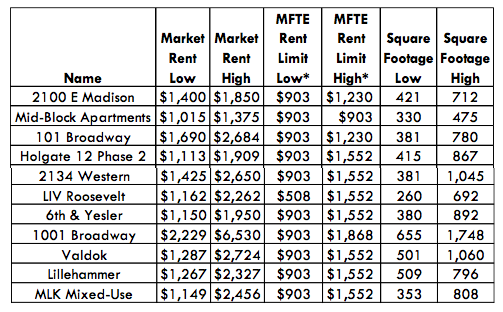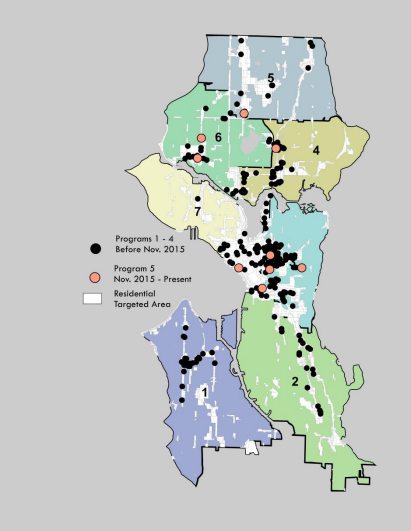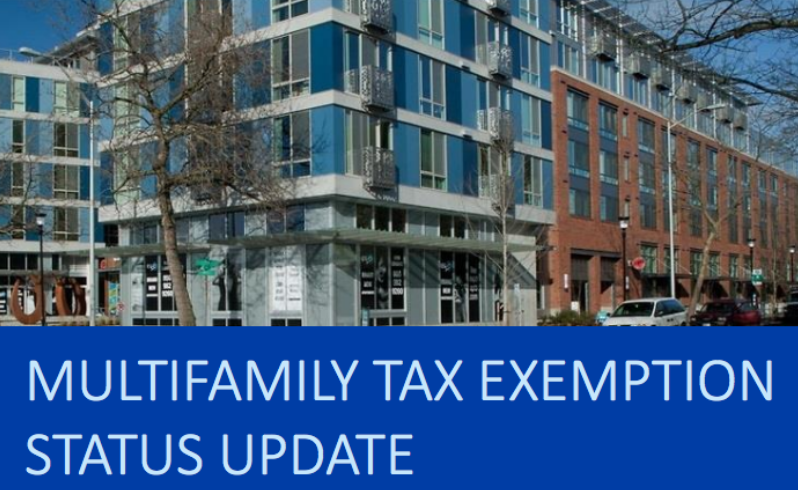The Office of Housing gave their thrice-annual progress report on the Multifamily Tax Exemption (MFTE) program to the City Council last month. The report analyzed the timeframe of January 1st to April 30th and highlighted shifting trends in the program, most evident by an increase in the number of projects participating in Family Size Unit Program. The total of new affordable housing projects entering the MFTE program was similar to the September to December timeframe in 2015. 11 MFTE applications were approved in the first trimester of this year versus 12 at the end of last year. However, the total number of MFTE restricted affordable units was down slightly 34 units.
In total, projects approved for the MFTE program would add 1,084 units of which 222 would become both income-restricted and rent-restrict for 12 years, leaving the remainder to market-rate pricing. This translates to about 20.4% of all units set-aside as restricted affordable units. One project entered the program under the older Program 4 conditions while 10 projects were approved under the newer Program 5.

Encouragingly, nine of the 10 projects approved under Program 5 met the standards for the Family Size Unit Program, that being project with four or more 2+ bedroom units set-aside as restricted affordable units, showing strong participation by developers in contributing family-sized units. And an important note, all of the approved projects are sponsored by private developers with the intent to become exclusively rental units.
The following is the total breakdown of units approved as standard units and restricted affordable units under the MFTE program:
| Unit Type | Number of Standard Units | Number of Income- and Rent-Restrict Units |
|---|---|---|
| SEDU | 29 | 8 |
| Congregate | 0 | 0 |
| Studio | 263 | 67 |
| 1BR | 442 | 113 |
| 2BR | 122 | 33 |
| 3BR | 6 | 1 |
| 4BR | 0 | 0 |
Program 5

The City Council reauthorized the MFTE program last fall and in doing so made revisions to where it is applicable and the amount and kind of units that qualify. The Office of Housing refers to this reauthorization as “Program 5” since it is the fifth generation of the MFTE program.
Adoption of Program 5 expanded the geographic area of the MFTE program to all parts of the city where multi-family residential is permitted by zoning. In the first trimester of this year, the Office of Housing approved two projects in Ballard and the Central District because of the geographic expansion, netting 27 MFTE units alone. Neither project would have qualified under Program 4.
Program 5 also made substantial changes to the parameters of qualifying unit amounts and types. A two-tier system was created by establishing a Family Size Unit Program and a Small Unit Program. There are three primary differences between the two programs:
- Projects with four or more affordable 2+ bedroom units can qualify for the Family Size Unit Program while projects with three or less such units can only qualify for the Small Unit Program.
- The Family Size Unit Program only requires 20% of units in a project to be set-aside as affordable whereas the Small Unit Program requires 25% of units to be set-aside as affordable.
- Three-bedroom units and congregate units were added into the mix for Program 5.
| Affordability Requirements | Program 4 | Program 5: Family Size Unit Program | Program 5: Small Unit Program |
|---|---|---|---|
| Affordable Unit Set-Aside | 20% of all unit types, 25% for SEDUs | 20% of all units | 25% of all units |
| Maximum Area Median Income (AMI) for Affordable Units by Unit Type | SEDU – 40% AMI Studio – 65% AMI 1 BR – 75% AMI 2 BR – 85% AMI | Unchanged, except: Congregate Units – 40% AMI 3 BR – 90% AMI | Unchanged, except: Congregate Units – 40% AMI 3 BR – 90% AMI |
Program 5 will remain in effect through December 31, 2019.
Program Participation
The Office of Housing says that developers are electing to participate in the MFTE at desirable rates and on par with previous years. Right now, the participation rate for eligible projects is about 50%. Office of Housing staffer Emily Alvarado explained the calibration of the program in this way:
One way to think about it is if 100% of the properties were participating in the MFTE program, it’s probably because we’re not asking for enough. That means luxury buildings would be participating in the program and the rent savings that we are getting off of the average building would not be good enough. If we’re getting zero participation because we’re setting affordability restrictions as too stringent, we would not be happy because we would not be getting any affordable units.
The participation rate in the program is not universally the same across the city. So far the general trend for higher participation rates in Program 5 is in lower rent neighborhoods (e.g., Licton Springs, International District, and Beacon Hill) than in higher rent neighborhoods (e.g., Capitol Hill and Downtown). Although, with less than two trimesters worth of data, it’s hard to know if that will remain true, especially considering than former programs had relativey robust showing in high rent neighborhoods.
Year Seven Properties, Good Value
The Office of Housing looked at “Year Seven” buildings in the MFTE program to see if units are still delivering significant rent savings at Year Seven compared to Year One.
In our annual report, we had one property that is currently in Year Seven of the 12-year MFTE period. It’s Alley 24 and we looked at the rents in that property. But since it was only one property, we looked at Dupre + Scott data. And it shows that in Year Seven buildings are still having rents that are comparable to market-rate rents on Year One of a building. They’re retaining a lot of their high rent value. And so we continue to get significant rent savings off of the properties, off of the units in Year Seven.
What those rent savings are: they are on average for studios $6,000 a year for a tenant and for the one-bedroom or two-bedroom units they’re more than $7,000 a year for a tenant. So that’s the delta between market-rate rents in new construction buildings and the affordable rents that are regulated under MFTE.
Family-Sized Housing Units
An important aspect in the recent report is that family-sized housing units are becoming a common feature in MFTE applications. Previously, developers had little interest in providing family-sized housing units because the MFTE program had fewer incentives for that housing type in Program 4. Still, the total number of family-sized units approved was down in the first trimester of the year; only 34 units family-sized units (33 two-bedroom units and 1 three-bedroom unit) were approved versus 67 two-bedroom units at the end of last year. That’s a big drop in restricted affordable family-sized units.
A unique difference between the end of last year and the first trimester of this year, however, is that the ratio of market-rate family-sized units to restricted affordable family-sized units is rising. [See our update below.] In the third trimester of 2015, the ratio was about 1.77 market-rate units to 1 restricted affordable unit whereas the ratio in the first trimester of 2016 was 3.76 market-rate units to 1 restricted affordable unit. This suggests that there is at least some sort of shift likely taking shape in the housing market toward higher rates of market-rate family-sized units. But will it continue? And will restricted affordable family-sized units see better results in Program 5 than Program 4?
Update 6/1/2016: The Office of Housing says that the market-rate to restricted affordable unit ratio is actually similar to the previous time period. Unfortunately, the February progress report did not break approved project types down by whether they were sponsored by private developers or non-profit developers to parse the data. Todd Burley, Communications Director, explains:
The third trimester of 2015 ratio is skewed by the inclusion of Othello East, a 100% affordable project being developed by Mercy Housing, while the first trimester of 2016 includes only market-rate projects. Removing Othello East from the third trimester of 2015 analysis yields a ratio of 4.10 market-rate family-size units for every one affordable family-size unit, which is more comparable.
So there goes any theory on substantially changed market conditions.
Stephen is a professional urban planner in Puget Sound with a passion for sustainable, livable, and diverse cities. He is especially interested in how policies, regulations, and programs can promote positive outcomes for communities. With stints in great cities like Bellingham and Cork, Stephen currently lives in Seattle. He primarily covers land use and transportation issues and has been with The Urbanist since 2014.


